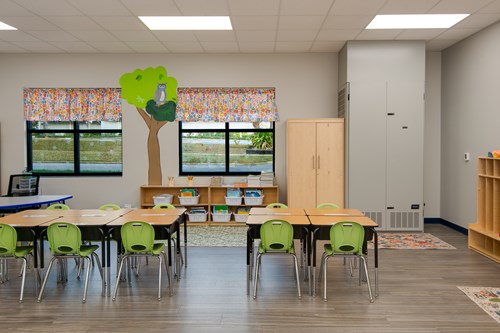For schools, HVAC is more than just a comfort system – it’s a critical component of student health, academic performance, and operational efficiency.
Studies show improved HVAC systems can result in lower absenteeism, reduced suspension rates, and higher test scores. Simply put, better climate comfort systems support students and teachers alike, and decentralized HVAC offers a solution that delivers exceptional comfort, air quality, and flexibility for both new construction and retrofits for aging school buildings.
Have a question? Email our engineers.
What is a Decentralized HVAC System?
Decentralization refers to the use of multiple independent HVAC units instead of a single, central unit to provide heating, ventilation, and cooling for a building. For schools, this means equipping each classroom and other independent spaces with their own comfort systems.
Key clarification: Decentralized can mean more than a single window unit or a mini split. Wall-mounts like those manufactured by Bard are a more effective form of decentralization. These factory-packaged systems allow schools to forgo large mechanical rooms and complex ductwork found in centralized systems in favor of localizing comfort control where it’s needed – in the classroom.
Wall-Mount vs. Mini Splits: What’s the Difference
Wall-Mount Units:
- Purpose-built for schools, with heating, cooling, ventilation, and dehumidification all in one packaged unit
- Integrated fresh air ventilation and MERV 13 filtration, which mini splits typically lack
- Designed for easy access by school staff and service technicians
- Factory-assembled to meet CSI MasterFormat standards for specifications
Mini Splits:
- Typically designed for residential or light commercial use
- Provide only heating and cooling with no dedicated ventilation or filtration
- Require multiple indoor heads tied to an outdoor condenser, adding installation complexity
- Less suited for the durability and air quality demands of school environments

4 Key Benefits of Decentralized HVAC for School Buildings
Construction and Installation Costs and Logistics
Decentralized HVAC systems offer a level of simplicity that can notably lower upfront construction and installation costs. Due to their design, decentralization eliminates the need for:
- Rooftop units
- Extensive ductwork and piping
- Large equipment rooms
- Demo and rebuild for above ceiling systems for retrofits
Another advantage of decentralizing is that it notably streamlines the construction and installation process. Smaller, factory-packaged equipment can reduce coordination complexity between trades and doesn’t need crane rentals or other specialized rigging equipment to lift them onto the roof. This more efficient process also is more compatible with tight construction timelines that require projects to be completed during a school break.
Improved Air Quality and Health
Air quality plays a massive role in students’ wellbeing, with airborne pollutants causing headaches, sneezing, and many other health problems. By giving each classroom its own individualized comfort system, schools can take steps to reduce the spread of infectious particles.
A decentralized HVAC system can provide a greater level of precision to create healthier learning environments and meet code requirements. Look for the following qualities to deliver better air for healthier schools:
- Room-by-room ventilation control allows schools to condition air based on actual occupancy instead of an average for multiple classrooms.
- High-MERV filtration up to MERV 13 that captures airborne viruses and fine particulates.
- Isolation of classroom ecosystems minimizes risk of cross-contamination.
- Integrated humidity control allows for improved comfort and mold prevention, especially in humid regions.
Want to learn more strategies for reducing the spread of infectious aerosols?
Download our Health is in the Air white paper

Better Energy Efficiency
Most schools rarely operate at full occupancy across every space at the same time. While centralized systems are optimized for peak demand, the need to bring in and treat extra outside air can add up on a school’s utility bills.
Individualized comfort systems give schools extra flexibility to lower annual energy consumption without sacrificing on comfort and air quality. Decentralization allows schools to improve their part-load performance and capitalize on energy efficiency by:
- Running units only in occupied rooms to not waste energy.
- Allowing room-by-room adjustments for sunlight, occupancy, or seasonal changes.
- Leveraging technology to provide the optimal amount of heating or cooling for each specific space.
Simplicity and Ease of Maintenance
Having a single, centralized HVAC system might sound simple, but these large, complicated systems can be a drag on maintenance staff and other school personnel. Some centralized systems may even be so complex that they require third-party contractors to complete basic fixes.
With the right decentralized system, schools can create less downtime and give their staff more control. Individualized units can simplify maintenance and operability by:
- Avoiding the need for roof access by being easy to access at the classroom level.
- Eliminating any above-ceiling work or need for an equipment room through self-contained wall-mount or interior units with easy access panels.
- Utilizing modular components and plug-and-play configurations that allow for quick, straightforward servicing by in-house maintenance staff or standard licensed contractors.
- Limiting issues to one wing of classrooms in case of any equipment failures, which is less disruptive when maintenance is needed compared to a traditional single system.
Final Thoughts: A Proven Path to Better School HVAC
Decentralized is more than just window units and other small-scale HVAC equipment – it’s an opportunity to embrace single, separate comfort systems that provide each space with the independent climate control they deserve.
At Bard, we help schools across the country invest in less invasive, budget-friendly HVAC systems that can provide healthy and comfortable conditions for students and teachers alike. We pioneered the concept of single separate comfort systems that deliver all-in-one, heating, cooling, dehumidifying, and ventilating for individual classrooms, and we take pride in providing high-quality products and premier customer support for schools across the U.S.
Breathe easy. You’ve got Bard.



